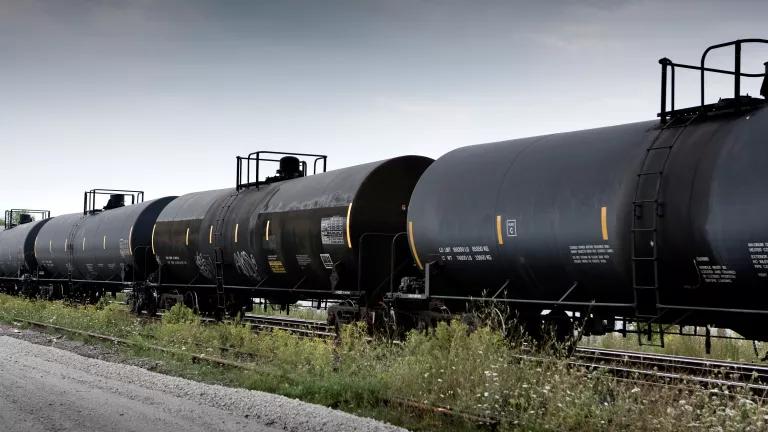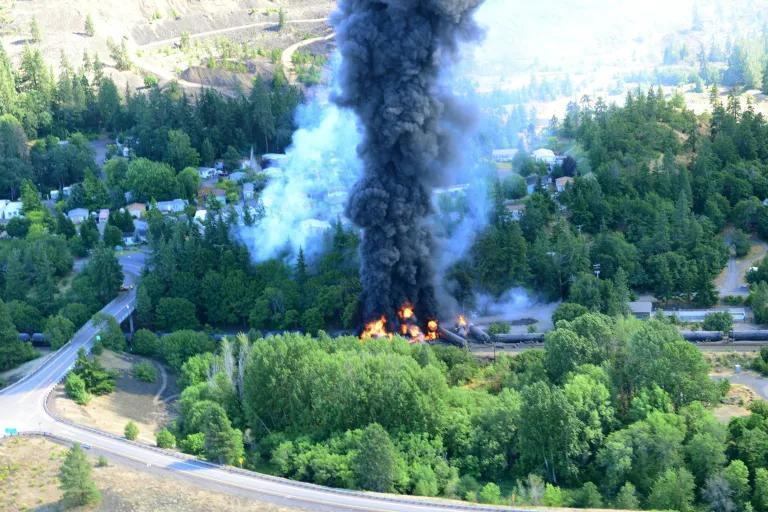Protect Your Community from “Bomb Trains”
Trains carrying highly explosive fossil fuels barrel through unsuspecting communities every day. Is yours one of them?

One of the deadliest rail accidents in recent history occurred nine years ago when a train derailed in Lac-Mégantic, Québec, killing 47 people and causing much of the small town to go up in flames. Images of the fires, which were fueled by 74 cars’ worth of volatile crude oil, opened peoples’ eyes to the extreme dangers of transporting oil by rail.
Since then, dozens of other similar accidents have occurred across the United States, where more than 25 million people live within a mile of a crude-by-rail route. The fracking boom and its subsequent expansion of oil refining has sent tanker trains crisscrossing the country: According to the Association of American Railroads, transport of crude skyrocketed from 9,500 carloads in 2008 to close to 500,000 carloads at its peak in 2014. By 2020, the number dropped to roughly 137,000. In the meantime, a new danger has emerged on the rails: liquefied natural gas (LNG). Environmental groups estimate that just 22 railcars of LNG hold the same amount of energy as the Hiroshima bomb.
The government previously prohibited transporting LNG by train, but in 2020, the Trump administration, in an effort to boost natural gas exports, gave the dangerous practice the green light. The administration also issued a special permit for a project that would transport LNG 200 miles between Pennsylvania and New Jersey through major cities like Philadelphia and Trenton. Late last year, NRDC and a coalition of other groups called on U.S. Department of Transportation Secretary Pete Buttigieg to follow through on his proposal to reinstate the ban.

Many people living near rail corridors are not even aware of these potential dangers, and should a derailment or collision happen, few communities have the equipment or trained personnel to deal with an accident involving large amounts of such volatile materials. But that doesn’t mean concerned citizens should feel helpless.
Find out if you’re at risk
If you live near train tracks that aren’t exclusively for passenger trains, there’s a chance your home, school, or place of work could lie within the impact zone of a train carrying fossil fuels. Search this online map, created by environmental advocacy group Stand.earth, to view all of the known crude-by-rail routes in the country, along with the government’s mandated half-mile evacuation radius for oil train derailments and one-mile potential impact zone in case of fire. Keep in mind that even outside the blast zone, you’re not necessarily safe—a crashed train full of crude oil has the potential to affect a much wider area, including contaminating waterways and harming air quality.
You can also tap into local networks of environmental advocates to learn about ill-conceived proposals like the Gibbstown LNG terminal in South Jersey, right outside of Philadelphia. Marcus Sibley, for example, the environmental and climate justice chairman for the New Jersey NAACP, is on a mission to educate the public about “bomb trains” and encourage residents to join in the fight against LNG transport by rail. “I'm focusing on the message of ‘you live here, this is coming here, there's a good chance you could be in the blast radius,’” he says. “It will be very important for these communities to speak out against the project because once it happens, it's too late. Once it’s here, it’s too late.”
Educate your local and state officials
If crude oil trains do run through your city or town, there may not be an easy way to stop them—at least not right now. But you can help educate your local and state officials, along with your fire department and emergency responders, of the risks to your community. Fire departments that are aware of these risks can at least make smarter calls about how to proceed in the event of an emergency.
Some cities have staged mock derailments, funded in part by the federal government, to practice responses like road closures and transporting injured bystanders to hospitals. Local and state governments can also push for safer conditions, with regular inspections and upkeep of tracks and (often old and crumbling) rail bridges. Some states have also begun requiring rail companies that transport crude oil through their cities to provide emergency response plans and the funds necessary to carry them out. A group of New Jersey activists who, in response to local crude-by-rail traffic, banded together as the Coalition to Ban Unsafe Oil Trains have advocated for just that.
Your state can also advocate for the federal government to act. Citing safety concerns after the June 2016 Mosier derailment, Oregon’s Department of Transportation asked the Federal Railroad Administration for a ban on oil trains statewide, for example. The following year, a six-state coalition, including New York and Washington, asked the Trump administration to close a regulatory loophole that allows bomb trains to roll through their states. And in August 2020, 14 states, including New Jersey and Pennsylvania, joined environmental groups in a lawsuit challenging the rule allowing LNG by rail. You can urge your state officials (and the federal government) to act too.
Make your own preparations
People who live near railways that transport crude oil or LNG should be aware of the potential for disaster—just like those who live in areas prone to wildfires, floods, or earthquakes. This may not change your decision to live there, but knowing how to respond in the case of a sudden evacuation is important. Make a plan with your family about where to go and how to reach each other in the event of an emergency, and keep disaster supply kits packed and at the ready.
“The emergency response officials who really understand this danger know there’s not much else you can do to prepare,” says Eddie Scher, former director of communications at Stand.earth. “We’ve worked with one fire chief in Minnesota who tells people, ‘Keep your sneakers close to your bed—that’s all you can really do.’”
Fight future expansion
While only the federal government can regulate train routes, city and state governments can control what new infrastructure gets approved within their borders. Many proposed rail projects must undergo state-level environmental reviews and public comment periods. You can stay abreast of these opportunities to weigh in by joining a local environmental advocacy group. Drafting a letter or speaking at a public hearing on the risks of crude- or LNG-by-rail is a good place to start.
Residents along the route to Gibbstown, for instance, have secured resolutions from local municipalities while organizations like Delaware Riverkeeper Network have helped them navigate the public commenting process.
Meanwhile, several communities have already successfully blocked expansion of oil industry infrastructure: Maryland state officials denied an application for a new crude-by-rail terminal in Baltimore in 2015, the same year that the New York State Department of Environmental Conservation, responding to strong community opposition, withdrew its approval of a plan to transfer oil from trains to barges on the Hudson River.
Opposing the expansion of bomb trains is the best way to send a message to the federal government that the risks they pose are unacceptable, says Anthony Swift, who directs NRDC’s Canada work. “To make the situation better, you have to first stop making it worse.”
This NRDC.org story is available for online republication by news media outlets or nonprofits under these conditions: The writer(s) must be credited with a byline; you must note prominently that the story was originally published by NRDC.org and link to the original; the story cannot be edited (beyond simple things such as grammar); you can’t resell the story in any form or grant republishing rights to other outlets; you can’t republish our material wholesale or automatically—you need to select stories individually; you can’t republish the photos or graphics on our site without specific permission; you should drop us a note to let us know when you’ve used one of our stories.


Gibbstown LNG Terminal: A Catastrophe Waiting to Happen
Mercury’s Journey from Coal-Burning Power Plants to Your Plate
Air Quality Is Worsening for Half of the World’s People